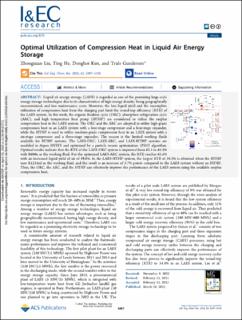| dc.contributor.author | Liu, Zhongxuan | |
| dc.contributor.author | He, Ting | |
| dc.contributor.author | Kim, Donghoi | |
| dc.contributor.author | Gundersen, Truls | |
| dc.date.accessioned | 2023-04-21T06:23:31Z | |
| dc.date.available | 2023-04-21T06:23:31Z | |
| dc.date.created | 2023-03-23T18:45:00Z | |
| dc.date.issued | 2023 | |
| dc.identifier.citation | Industrial & Engineering Chemistry Research. 2023, 62 5097-5108. | en_US |
| dc.identifier.issn | 0888-5885 | |
| dc.identifier.uri | https://hdl.handle.net/11250/3064128 | |
| dc.description.abstract | Liquid air energy storage (LAES) is regarded as one of the promising large-scale energy storage technologies due to its characteristics of high energy density, being geographically unconstrained, and low maintenance costs. However, the low liquid yield and the incomplete utilization of compression heat from the charging part limit the round-trip efficiency (RTE) of the LAES system. In this work, the organic Rankine cycle (ORC), absorption refrigeration cycle (ARC), and high temperature heat pump (HTHP) are considered to utilize the surplus compression heat in the LAES system. The ORC and the ARC are adopted to utilize high-grade compression heat in an LAES system with a four-stage compressor and a four-stage expander, while the HTHP is used to utilize medium-grade compression heat in an LAES system with a six-stage compressor and a three-stage expander. The reason is the limited working fluids available for HTHP systems. The LAES-ORC, LAES-ARC, and LAES-HTHP systems are modeled in Aspen HYSYS and optimized by a particle swarm optimization (PSO) algorithm. Optimal results indicate that the RTE of the LAES-ORC system is improved from 62.1 to 64.5% with R600a as the working fluid. For the optimized LAES-ARC system, the RTE reaches 63.5% with an increased liquid yield of air of 89.6%. In the LAES-HTHP system, the largest RTE of 58.3% is obtained when the HTHP uses R1233zd as the working fluid, and the result is an increase of 3.7% points compared to the LAES system without an HTHP. Thus, the ORC, the ARC, and the HTHP can effectively improve the performance of the LAES system using the available surplus compression heat. | en_US |
| dc.language.iso | eng | en_US |
| dc.publisher | American Chemical Society | en_US |
| dc.rights | Navngivelse 4.0 Internasjonal | * |
| dc.rights.uri | http://creativecommons.org/licenses/by/4.0/deed.no | * |
| dc.title | Optimal utilization of compression heat in liquid air energy storage | en_US |
| dc.title.alternative | Optimal utilization of compression heat in liquid air energy storage | en_US |
| dc.type | Peer reviewed | en_US |
| dc.type | Journal article | en_US |
| dc.description.version | publishedVersion | en_US |
| dc.source.pagenumber | 5097-5108 | en_US |
| dc.source.volume | 62 | en_US |
| dc.source.journal | Industrial & Engineering Chemistry Research | en_US |
| dc.source.issue | 12 | en_US |
| dc.identifier.doi | 10.1021/acs.iecr.2c04059 | |
| dc.identifier.cristin | 2136568 | |
| cristin.ispublished | true | |
| cristin.fulltext | original | |
| cristin.qualitycode | 2 | |

